PUB708 Project Report: Investigating Coffee's Impact on Blood Pressure
VerifiedAdded on 2023/06/03
|47
|5531
|107
Report
AI Summary
This report presents a quantitative research study investigating the impact of hot coffee consumption on human blood pressure. The study, conducted with 50 participants, examines the effects of coffee on both systolic and diastolic blood pressure. The methodology includes a paired t-test to compare pre- and post-coffee blood pressure readings, as well as linear regression analysis to assess the influence of age and gender. The results indicate no statistically significant impact of coffee on either systolic or diastolic blood pressure. The report includes descriptive statistics, such as mean and standard deviation, for different age and gender groups. The analysis also considers the correlation between pre- and post-blood pressure measurements. The study concludes that coffee consumption, under the conditions of the experiment, does not significantly affect blood pressure levels. The report also includes the results of normality tests (Shapiro-Wilk) and diagnostics for the linear regression model.
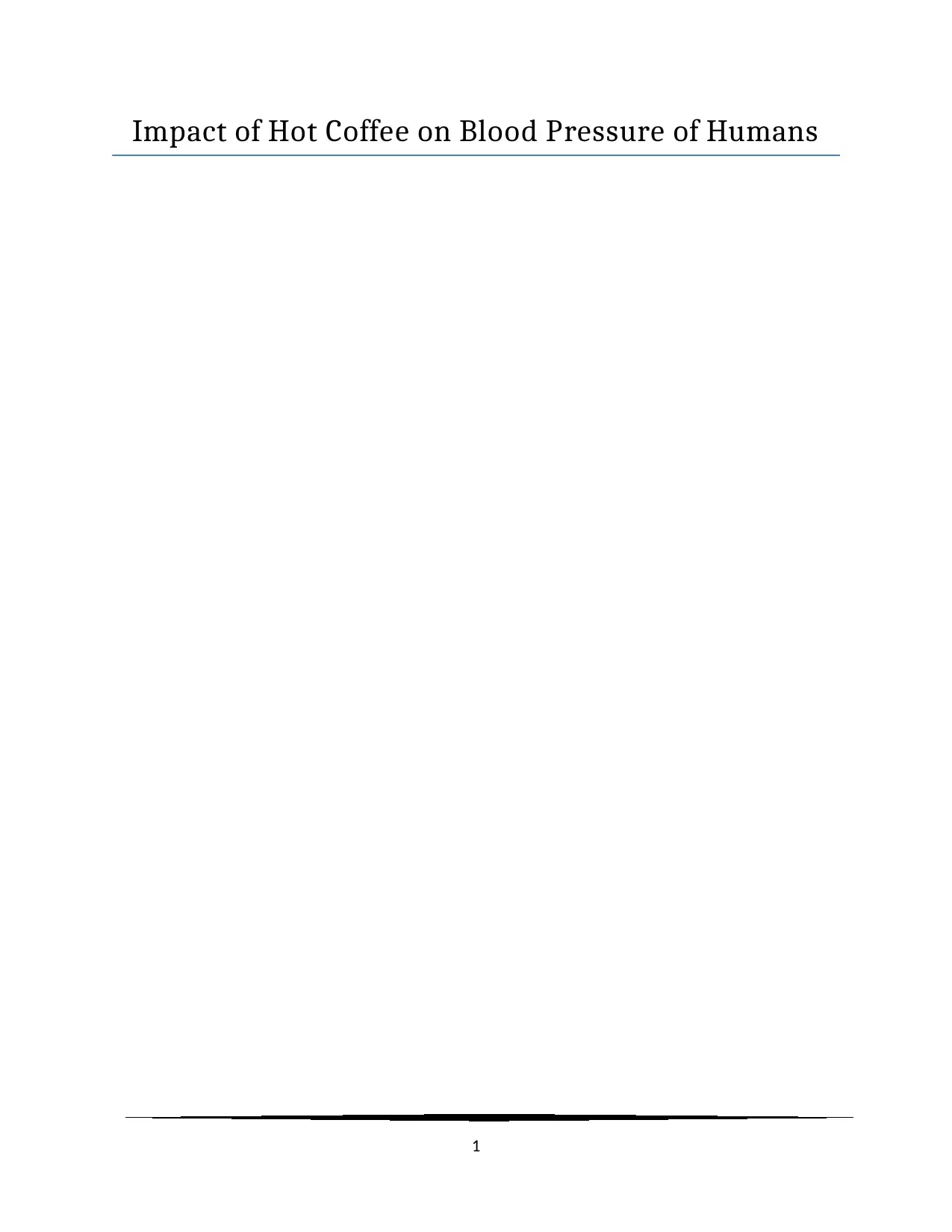
Impact of Hot Coffee on Blood Pressure of Humans
1
1
Paraphrase This Document
Need a fresh take? Get an instant paraphrase of this document with our AI Paraphraser
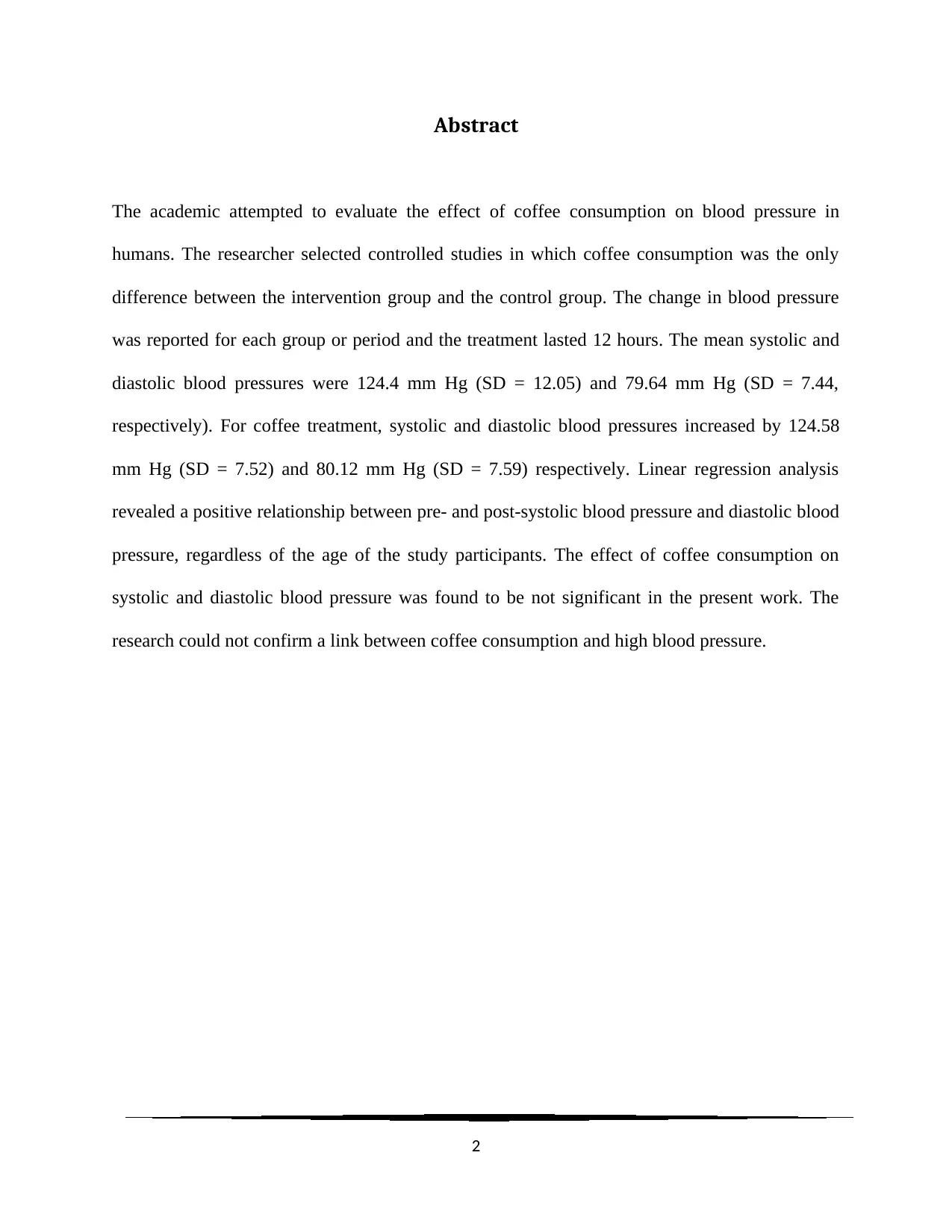
Abstract
The academic attempted to evaluate the effect of coffee consumption on blood pressure in
humans. The researcher selected controlled studies in which coffee consumption was the only
difference between the intervention group and the control group. The change in blood pressure
was reported for each group or period and the treatment lasted 12 hours. The mean systolic and
diastolic blood pressures were 124.4 mm Hg (SD = 12.05) and 79.64 mm Hg (SD = 7.44,
respectively). For coffee treatment, systolic and diastolic blood pressures increased by 124.58
mm Hg (SD = 7.52) and 80.12 mm Hg (SD = 7.59) respectively. Linear regression analysis
revealed a positive relationship between pre- and post-systolic blood pressure and diastolic blood
pressure, regardless of the age of the study participants. The effect of coffee consumption on
systolic and diastolic blood pressure was found to be not significant in the present work. The
research could not confirm a link between coffee consumption and high blood pressure.
2
The academic attempted to evaluate the effect of coffee consumption on blood pressure in
humans. The researcher selected controlled studies in which coffee consumption was the only
difference between the intervention group and the control group. The change in blood pressure
was reported for each group or period and the treatment lasted 12 hours. The mean systolic and
diastolic blood pressures were 124.4 mm Hg (SD = 12.05) and 79.64 mm Hg (SD = 7.44,
respectively). For coffee treatment, systolic and diastolic blood pressures increased by 124.58
mm Hg (SD = 7.52) and 80.12 mm Hg (SD = 7.59) respectively. Linear regression analysis
revealed a positive relationship between pre- and post-systolic blood pressure and diastolic blood
pressure, regardless of the age of the study participants. The effect of coffee consumption on
systolic and diastolic blood pressure was found to be not significant in the present work. The
research could not confirm a link between coffee consumption and high blood pressure.
2
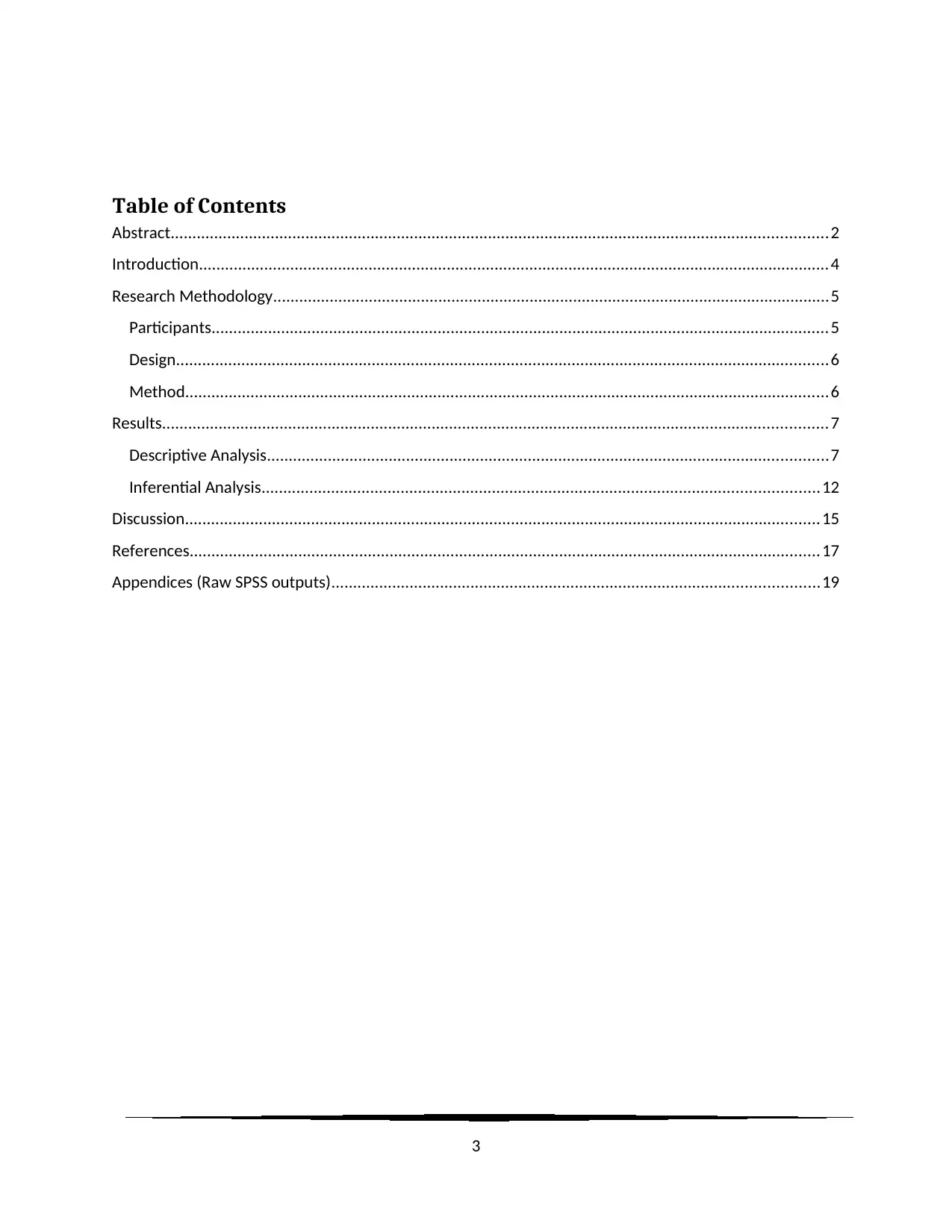
Table of Contents
Abstract.......................................................................................................................................................2
Introduction.................................................................................................................................................4
Research Methodology................................................................................................................................5
Participants..............................................................................................................................................5
Design......................................................................................................................................................6
Method....................................................................................................................................................6
Results.........................................................................................................................................................7
Descriptive Analysis.................................................................................................................................7
Inferential Analysis................................................................................................................................12
Discussion..................................................................................................................................................15
References.................................................................................................................................................17
Appendices (Raw SPSS outputs)................................................................................................................19
3
Abstract.......................................................................................................................................................2
Introduction.................................................................................................................................................4
Research Methodology................................................................................................................................5
Participants..............................................................................................................................................5
Design......................................................................................................................................................6
Method....................................................................................................................................................6
Results.........................................................................................................................................................7
Descriptive Analysis.................................................................................................................................7
Inferential Analysis................................................................................................................................12
Discussion..................................................................................................................................................15
References.................................................................................................................................................17
Appendices (Raw SPSS outputs)................................................................................................................19
3
⊘ This is a preview!⊘
Do you want full access?
Subscribe today to unlock all pages.

Trusted by 1+ million students worldwide
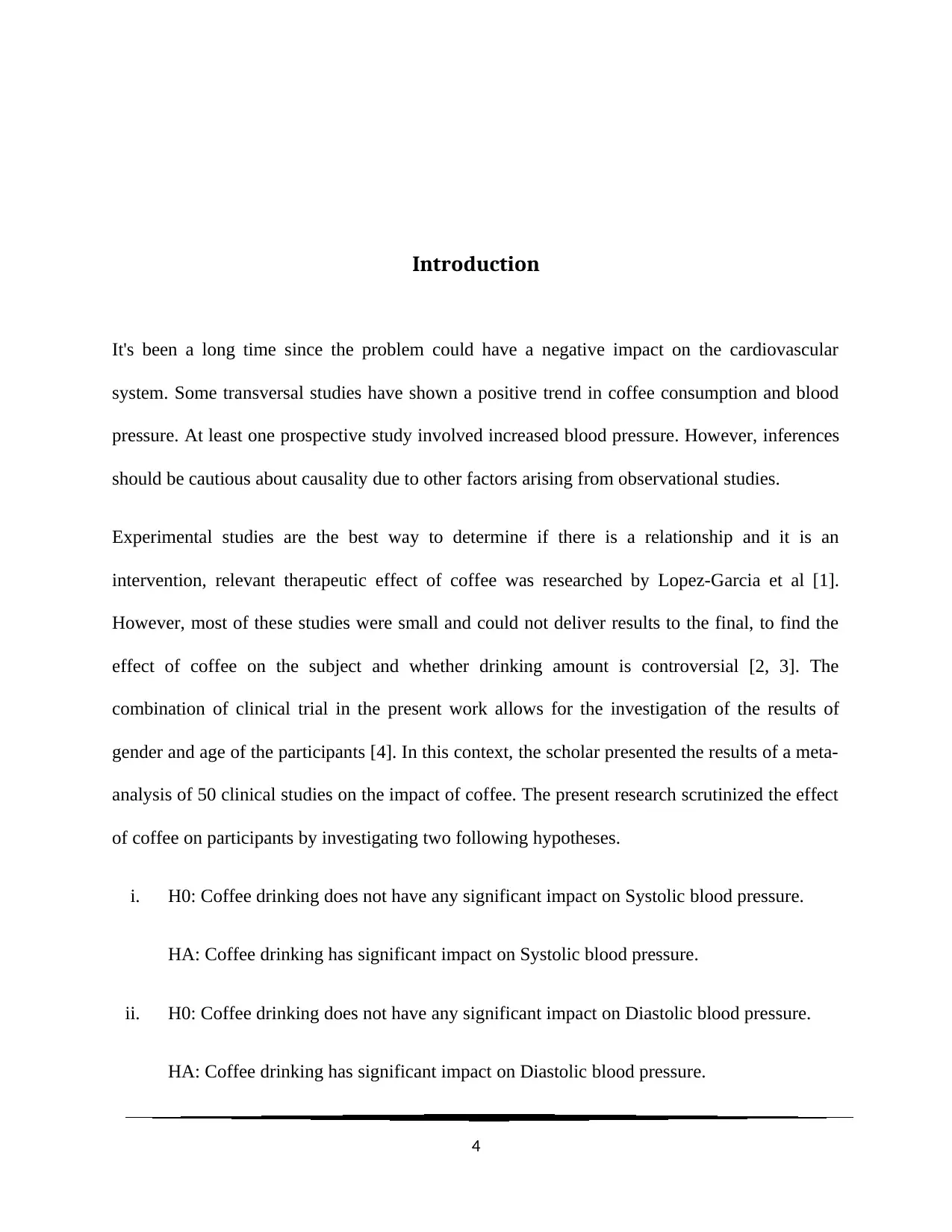
Introduction
It's been a long time since the problem could have a negative impact on the cardiovascular
system. Some transversal studies have shown a positive trend in coffee consumption and blood
pressure. At least one prospective study involved increased blood pressure. However, inferences
should be cautious about causality due to other factors arising from observational studies.
Experimental studies are the best way to determine if there is a relationship and it is an
intervention, relevant therapeutic effect of coffee was researched by Lopez-Garcia et al [1].
However, most of these studies were small and could not deliver results to the final, to find the
effect of coffee on the subject and whether drinking amount is controversial [2, 3]. The
combination of clinical trial in the present work allows for the investigation of the results of
gender and age of the participants [4]. In this context, the scholar presented the results of a meta-
analysis of 50 clinical studies on the impact of coffee. The present research scrutinized the effect
of coffee on participants by investigating two following hypotheses.
i. H0: Coffee drinking does not have any significant impact on Systolic blood pressure.
HA: Coffee drinking has significant impact on Systolic blood pressure.
ii. H0: Coffee drinking does not have any significant impact on Diastolic blood pressure.
HA: Coffee drinking has significant impact on Diastolic blood pressure.
4
It's been a long time since the problem could have a negative impact on the cardiovascular
system. Some transversal studies have shown a positive trend in coffee consumption and blood
pressure. At least one prospective study involved increased blood pressure. However, inferences
should be cautious about causality due to other factors arising from observational studies.
Experimental studies are the best way to determine if there is a relationship and it is an
intervention, relevant therapeutic effect of coffee was researched by Lopez-Garcia et al [1].
However, most of these studies were small and could not deliver results to the final, to find the
effect of coffee on the subject and whether drinking amount is controversial [2, 3]. The
combination of clinical trial in the present work allows for the investigation of the results of
gender and age of the participants [4]. In this context, the scholar presented the results of a meta-
analysis of 50 clinical studies on the impact of coffee. The present research scrutinized the effect
of coffee on participants by investigating two following hypotheses.
i. H0: Coffee drinking does not have any significant impact on Systolic blood pressure.
HA: Coffee drinking has significant impact on Systolic blood pressure.
ii. H0: Coffee drinking does not have any significant impact on Diastolic blood pressure.
HA: Coffee drinking has significant impact on Diastolic blood pressure.
4
Paraphrase This Document
Need a fresh take? Get an instant paraphrase of this document with our AI Paraphraser
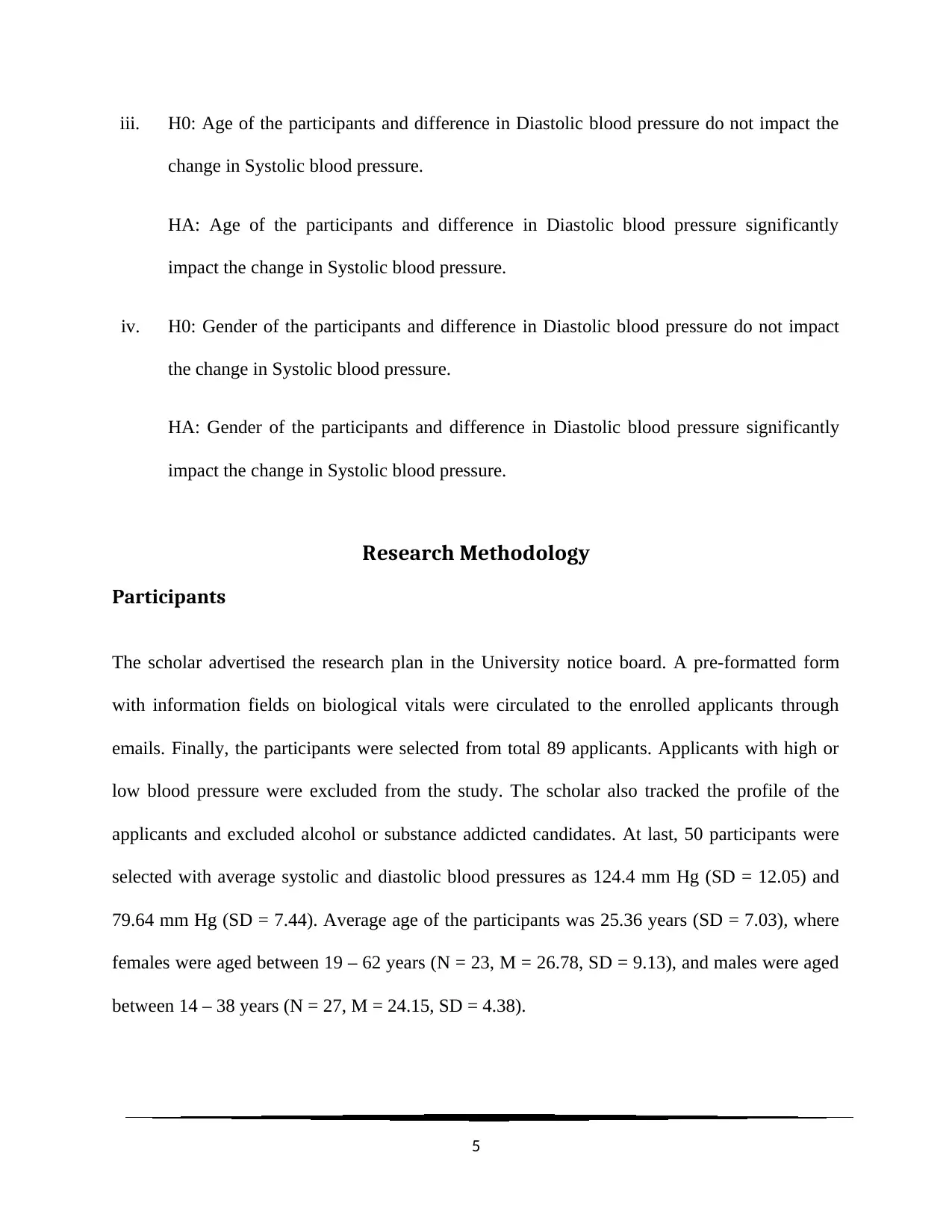
iii. H0: Age of the participants and difference in Diastolic blood pressure do not impact the
change in Systolic blood pressure.
HA: Age of the participants and difference in Diastolic blood pressure significantly
impact the change in Systolic blood pressure.
iv. H0: Gender of the participants and difference in Diastolic blood pressure do not impact
the change in Systolic blood pressure.
HA: Gender of the participants and difference in Diastolic blood pressure significantly
impact the change in Systolic blood pressure.
Research Methodology
Participants
The scholar advertised the research plan in the University notice board. A pre-formatted form
with information fields on biological vitals were circulated to the enrolled applicants through
emails. Finally, the participants were selected from total 89 applicants. Applicants with high or
low blood pressure were excluded from the study. The scholar also tracked the profile of the
applicants and excluded alcohol or substance addicted candidates. At last, 50 participants were
selected with average systolic and diastolic blood pressures as 124.4 mm Hg (SD = 12.05) and
79.64 mm Hg (SD = 7.44). Average age of the participants was 25.36 years (SD = 7.03), where
females were aged between 19 – 62 years (N = 23, M = 26.78, SD = 9.13), and males were aged
between 14 – 38 years (N = 27, M = 24.15, SD = 4.38).
5
change in Systolic blood pressure.
HA: Age of the participants and difference in Diastolic blood pressure significantly
impact the change in Systolic blood pressure.
iv. H0: Gender of the participants and difference in Diastolic blood pressure do not impact
the change in Systolic blood pressure.
HA: Gender of the participants and difference in Diastolic blood pressure significantly
impact the change in Systolic blood pressure.
Research Methodology
Participants
The scholar advertised the research plan in the University notice board. A pre-formatted form
with information fields on biological vitals were circulated to the enrolled applicants through
emails. Finally, the participants were selected from total 89 applicants. Applicants with high or
low blood pressure were excluded from the study. The scholar also tracked the profile of the
applicants and excluded alcohol or substance addicted candidates. At last, 50 participants were
selected with average systolic and diastolic blood pressures as 124.4 mm Hg (SD = 12.05) and
79.64 mm Hg (SD = 7.44). Average age of the participants was 25.36 years (SD = 7.03), where
females were aged between 19 – 62 years (N = 23, M = 26.78, SD = 9.13), and males were aged
between 14 – 38 years (N = 27, M = 24.15, SD = 4.38).
5
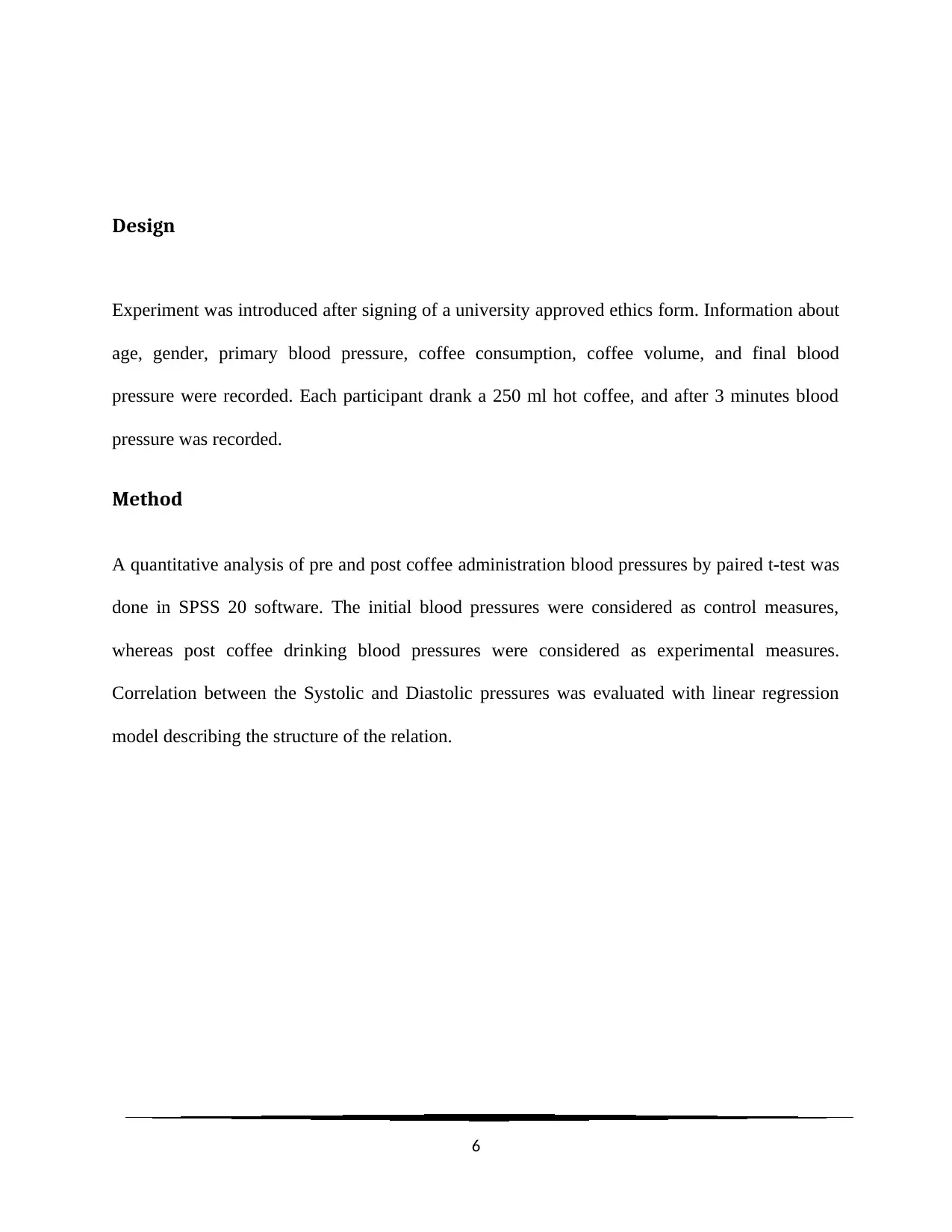
Design
Experiment was introduced after signing of a university approved ethics form. Information about
age, gender, primary blood pressure, coffee consumption, coffee volume, and final blood
pressure were recorded. Each participant drank a 250 ml hot coffee, and after 3 minutes blood
pressure was recorded.
Method
A quantitative analysis of pre and post coffee administration blood pressures by paired t-test was
done in SPSS 20 software. The initial blood pressures were considered as control measures,
whereas post coffee drinking blood pressures were considered as experimental measures.
Correlation between the Systolic and Diastolic pressures was evaluated with linear regression
model describing the structure of the relation.
6
Experiment was introduced after signing of a university approved ethics form. Information about
age, gender, primary blood pressure, coffee consumption, coffee volume, and final blood
pressure were recorded. Each participant drank a 250 ml hot coffee, and after 3 minutes blood
pressure was recorded.
Method
A quantitative analysis of pre and post coffee administration blood pressures by paired t-test was
done in SPSS 20 software. The initial blood pressures were considered as control measures,
whereas post coffee drinking blood pressures were considered as experimental measures.
Correlation between the Systolic and Diastolic pressures was evaluated with linear regression
model describing the structure of the relation.
6
⊘ This is a preview!⊘
Do you want full access?
Subscribe today to unlock all pages.

Trusted by 1+ million students worldwide
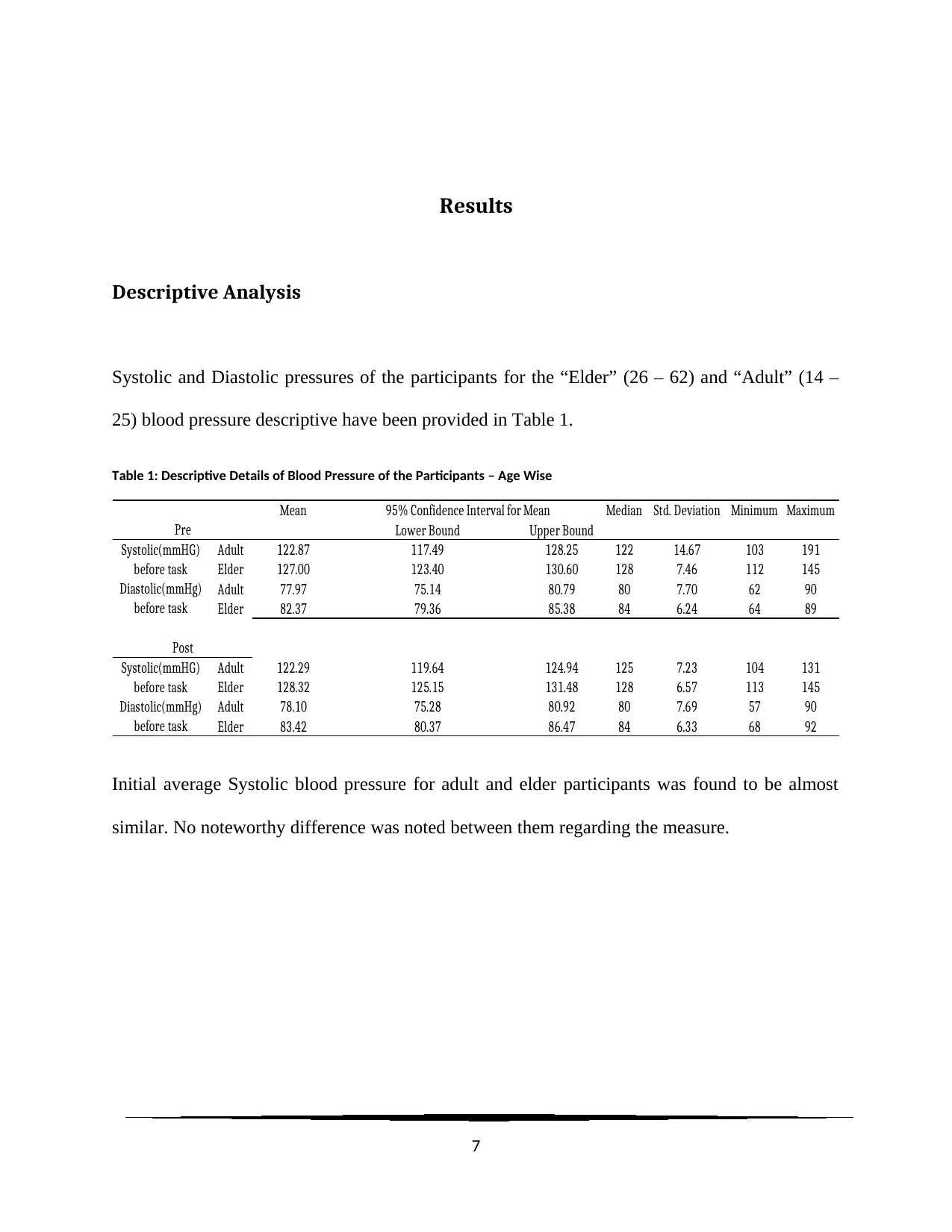
Results
Descriptive Analysis
Systolic and Diastolic pressures of the participants for the “Elder” (26 – 62) and “Adult” (14 –
25) blood pressure descriptive have been provided in Table 1.
Table 1: Descriptive Details of Blood Pressure of the Participants – Age Wise
Mean Median Std. Deviation Minimum Maximum
Lower Bound Upper Bound
Adult 122.87 117.49 128.25 122 14.67 103 191
Elder 127.00 123.40 130.60 128 7.46 112 145
Adult 77.97 75.14 80.79 80 7.70 62 90
Elder 82.37 79.36 85.38 84 6.24 64 89
Adult 122.29 119.64 124.94 125 7.23 104 131
Elder 128.32 125.15 131.48 128 6.57 113 145
Adult 78.10 75.28 80.92 80 7.69 57 90
Elder 83.42 80.37 86.47 84 6.33 68 92
Systolic(mmHG)
before task
Diastolic(mmHg)
before task
95% Confidence Interval for Mean
Pre
Systolic(mmHG)
before task
Diastolic(mmHg)
before task
Post
Initial average Systolic blood pressure for adult and elder participants was found to be almost
similar. No noteworthy difference was noted between them regarding the measure.
7
Descriptive Analysis
Systolic and Diastolic pressures of the participants for the “Elder” (26 – 62) and “Adult” (14 –
25) blood pressure descriptive have been provided in Table 1.
Table 1: Descriptive Details of Blood Pressure of the Participants – Age Wise
Mean Median Std. Deviation Minimum Maximum
Lower Bound Upper Bound
Adult 122.87 117.49 128.25 122 14.67 103 191
Elder 127.00 123.40 130.60 128 7.46 112 145
Adult 77.97 75.14 80.79 80 7.70 62 90
Elder 82.37 79.36 85.38 84 6.24 64 89
Adult 122.29 119.64 124.94 125 7.23 104 131
Elder 128.32 125.15 131.48 128 6.57 113 145
Adult 78.10 75.28 80.92 80 7.69 57 90
Elder 83.42 80.37 86.47 84 6.33 68 92
Systolic(mmHG)
before task
Diastolic(mmHg)
before task
95% Confidence Interval for Mean
Pre
Systolic(mmHG)
before task
Diastolic(mmHg)
before task
Post
Initial average Systolic blood pressure for adult and elder participants was found to be almost
similar. No noteworthy difference was noted between them regarding the measure.
7
Paraphrase This Document
Need a fresh take? Get an instant paraphrase of this document with our AI Paraphraser
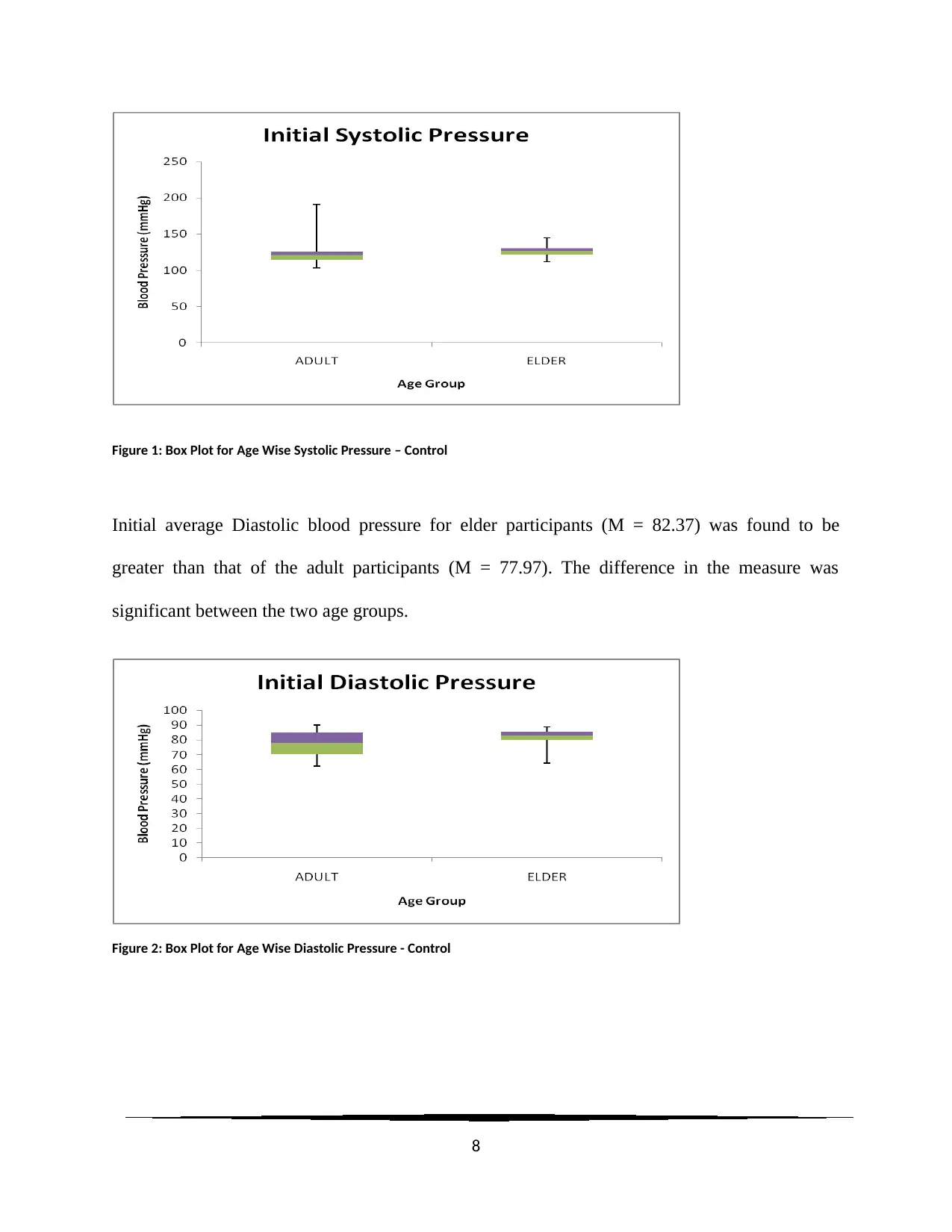
Figure 1: Box Plot for Age Wise Systolic Pressure – Control
Initial average Diastolic blood pressure for elder participants (M = 82.37) was found to be
greater than that of the adult participants (M = 77.97). The difference in the measure was
significant between the two age groups.
Figure 2: Box Plot for Age Wise Diastolic Pressure - Control
8
Initial average Diastolic blood pressure for elder participants (M = 82.37) was found to be
greater than that of the adult participants (M = 77.97). The difference in the measure was
significant between the two age groups.
Figure 2: Box Plot for Age Wise Diastolic Pressure - Control
8
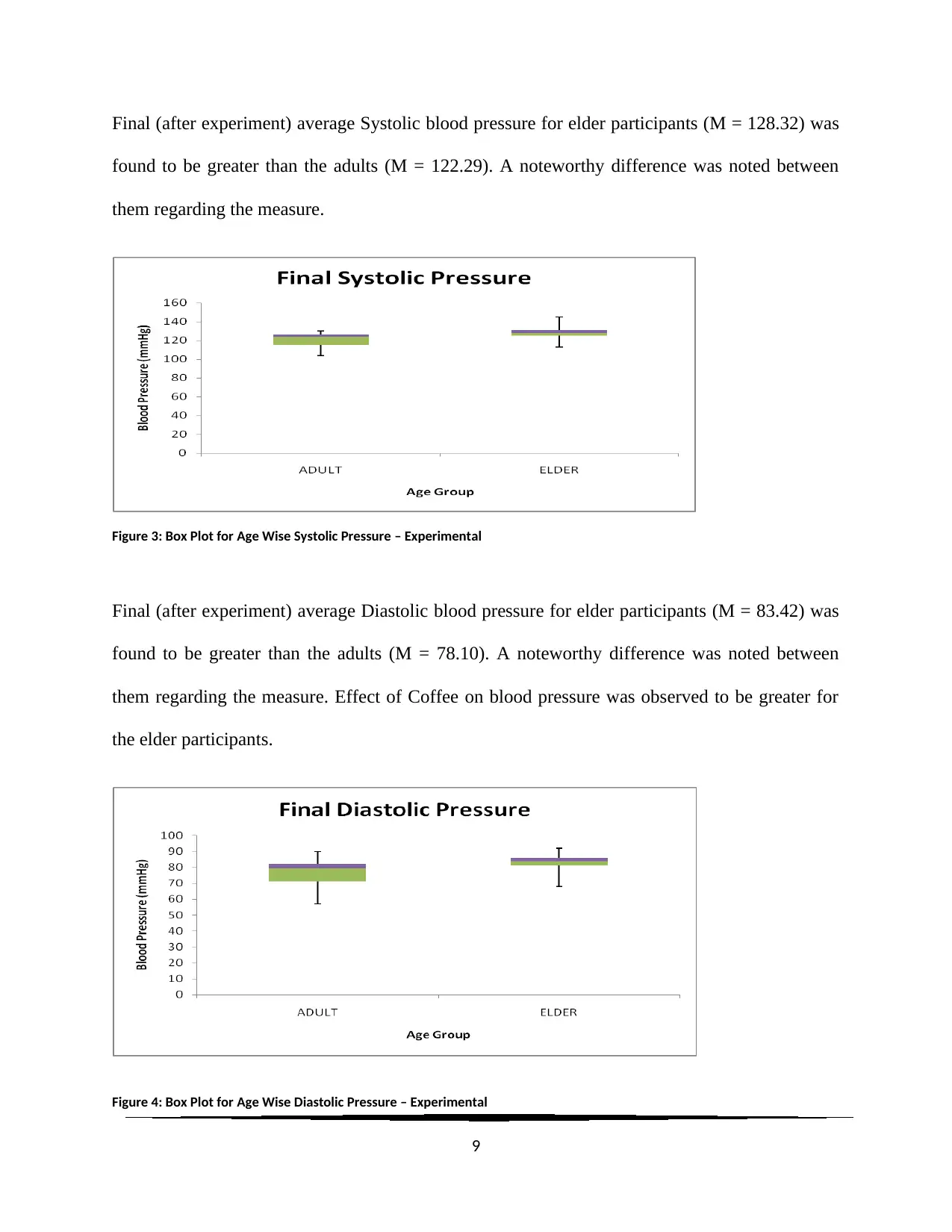
Final (after experiment) average Systolic blood pressure for elder participants (M = 128.32) was
found to be greater than the adults (M = 122.29). A noteworthy difference was noted between
them regarding the measure.
Figure 3: Box Plot for Age Wise Systolic Pressure – Experimental
Final (after experiment) average Diastolic blood pressure for elder participants (M = 83.42) was
found to be greater than the adults (M = 78.10). A noteworthy difference was noted between
them regarding the measure. Effect of Coffee on blood pressure was observed to be greater for
the elder participants.
Figure 4: Box Plot for Age Wise Diastolic Pressure – Experimental
9
found to be greater than the adults (M = 122.29). A noteworthy difference was noted between
them regarding the measure.
Figure 3: Box Plot for Age Wise Systolic Pressure – Experimental
Final (after experiment) average Diastolic blood pressure for elder participants (M = 83.42) was
found to be greater than the adults (M = 78.10). A noteworthy difference was noted between
them regarding the measure. Effect of Coffee on blood pressure was observed to be greater for
the elder participants.
Figure 4: Box Plot for Age Wise Diastolic Pressure – Experimental
9
⊘ This is a preview!⊘
Do you want full access?
Subscribe today to unlock all pages.

Trusted by 1+ million students worldwide
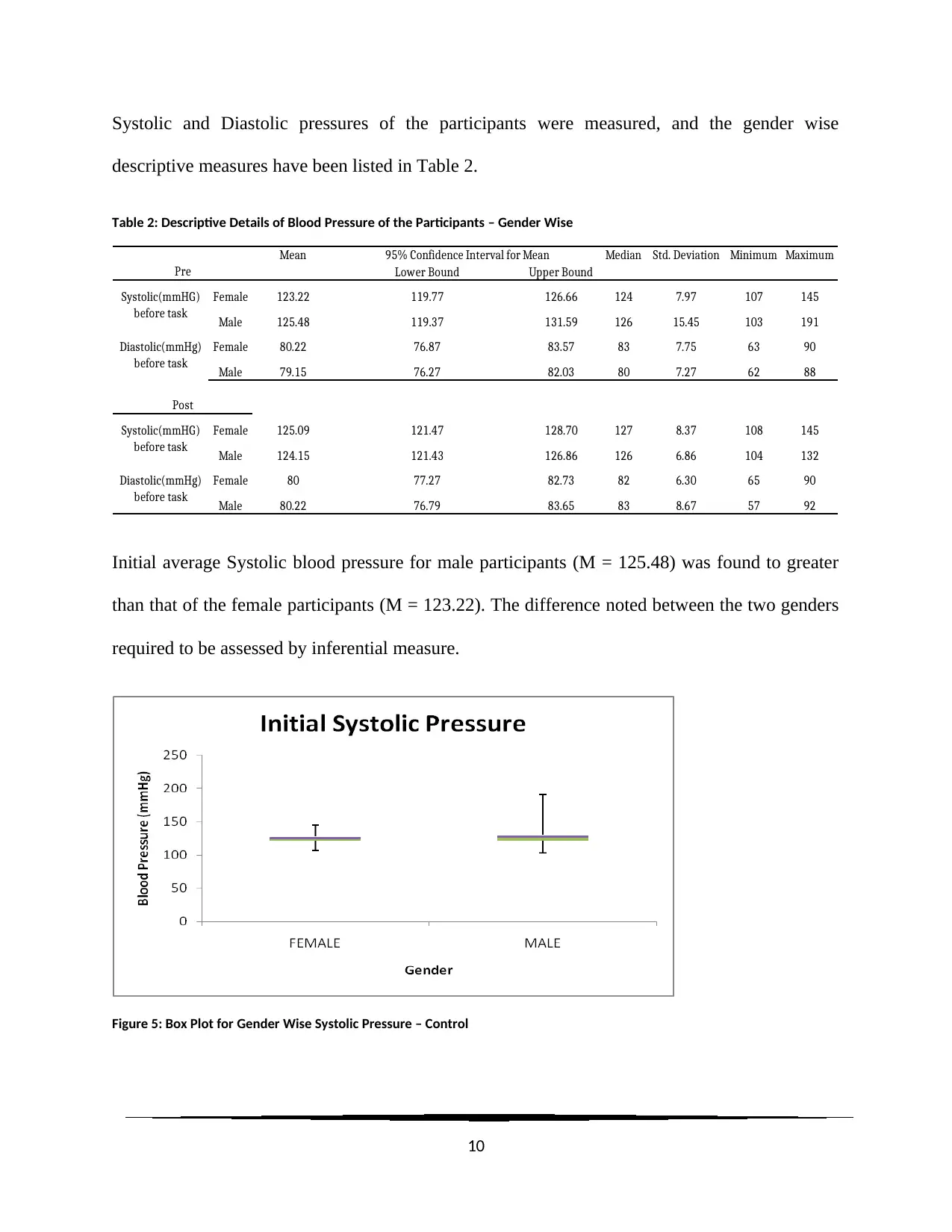
Systolic and Diastolic pressures of the participants were measured, and the gender wise
descriptive measures have been listed in Table 2.
Table 2: Descriptive Details of Blood Pressure of the Participants – Gender Wise
Mean Median Std. Deviation Minimum Maximum
Lower Bound Upper Bound
Female 123.22 119.77 126.66 124 7.97 107 145
Male 125.48 119.37 131.59 126 15.45 103 191
Female 80.22 76.87 83.57 83 7.75 63 90
Male 79.15 76.27 82.03 80 7.27 62 88
Female 125.09 121.47 128.70 127 8.37 108 145
Male 124.15 121.43 126.86 126 6.86 104 132
Female 80 77.27 82.73 82 6.30 65 90
Male 80.22 76.79 83.65 83 8.67 57 92
95% Confidence Interval for Mean
Pre
Post
Diastolic(mmHg)
before task
Systolic(mmHG)
before task
Diastolic(mmHg)
before task
Systolic(mmHG)
before task
Initial average Systolic blood pressure for male participants (M = 125.48) was found to greater
than that of the female participants (M = 123.22). The difference noted between the two genders
required to be assessed by inferential measure.
Figure 5: Box Plot for Gender Wise Systolic Pressure – Control
10
descriptive measures have been listed in Table 2.
Table 2: Descriptive Details of Blood Pressure of the Participants – Gender Wise
Mean Median Std. Deviation Minimum Maximum
Lower Bound Upper Bound
Female 123.22 119.77 126.66 124 7.97 107 145
Male 125.48 119.37 131.59 126 15.45 103 191
Female 80.22 76.87 83.57 83 7.75 63 90
Male 79.15 76.27 82.03 80 7.27 62 88
Female 125.09 121.47 128.70 127 8.37 108 145
Male 124.15 121.43 126.86 126 6.86 104 132
Female 80 77.27 82.73 82 6.30 65 90
Male 80.22 76.79 83.65 83 8.67 57 92
95% Confidence Interval for Mean
Pre
Post
Diastolic(mmHg)
before task
Systolic(mmHG)
before task
Diastolic(mmHg)
before task
Systolic(mmHG)
before task
Initial average Systolic blood pressure for male participants (M = 125.48) was found to greater
than that of the female participants (M = 123.22). The difference noted between the two genders
required to be assessed by inferential measure.
Figure 5: Box Plot for Gender Wise Systolic Pressure – Control
10
Paraphrase This Document
Need a fresh take? Get an instant paraphrase of this document with our AI Paraphraser
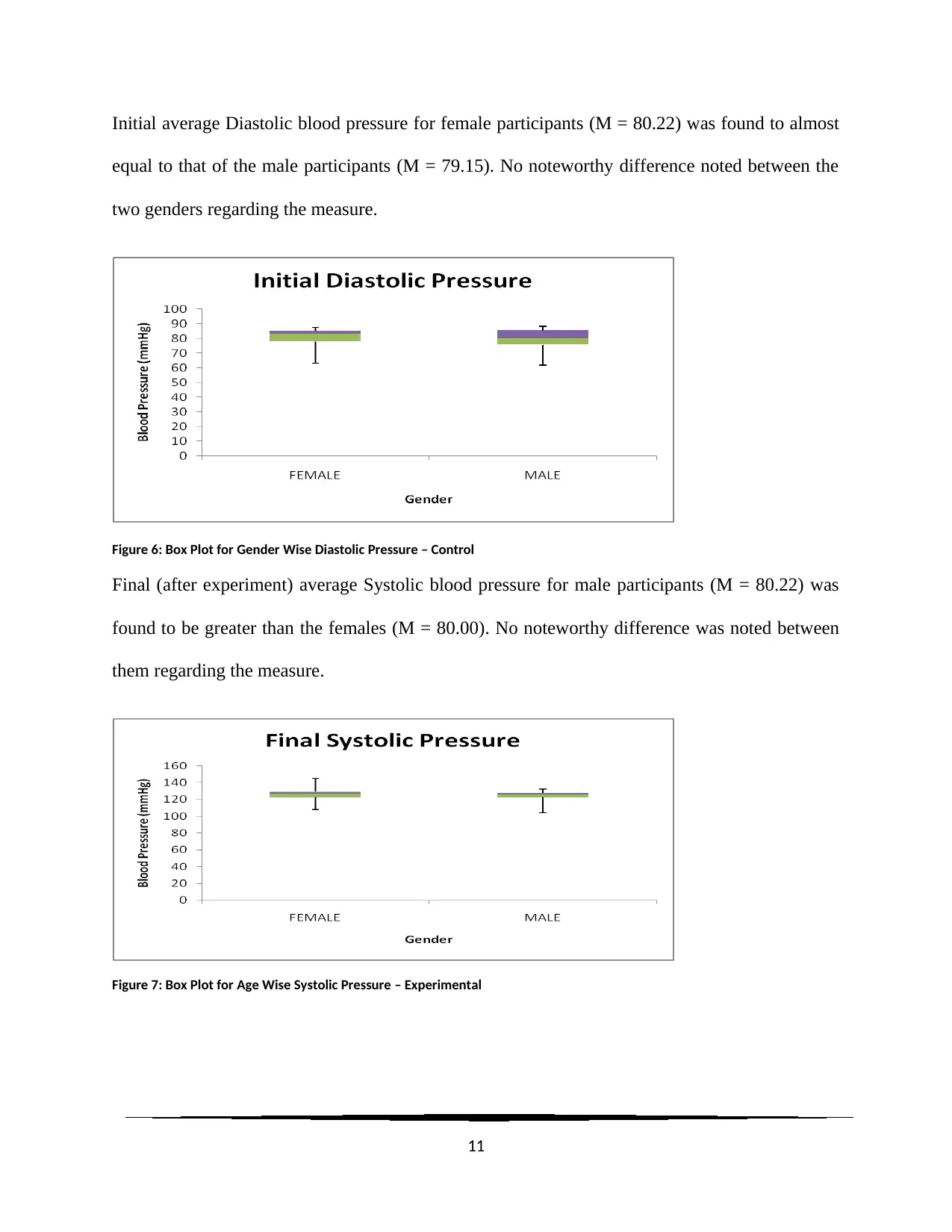
Initial average Diastolic blood pressure for female participants (M = 80.22) was found to almost
equal to that of the male participants (M = 79.15). No noteworthy difference noted between the
two genders regarding the measure.
Figure 6: Box Plot for Gender Wise Diastolic Pressure – Control
Final (after experiment) average Systolic blood pressure for male participants (M = 80.22) was
found to be greater than the females (M = 80.00). No noteworthy difference was noted between
them regarding the measure.
Figure 7: Box Plot for Age Wise Systolic Pressure – Experimental
11
equal to that of the male participants (M = 79.15). No noteworthy difference noted between the
two genders regarding the measure.
Figure 6: Box Plot for Gender Wise Diastolic Pressure – Control
Final (after experiment) average Systolic blood pressure for male participants (M = 80.22) was
found to be greater than the females (M = 80.00). No noteworthy difference was noted between
them regarding the measure.
Figure 7: Box Plot for Age Wise Systolic Pressure – Experimental
11
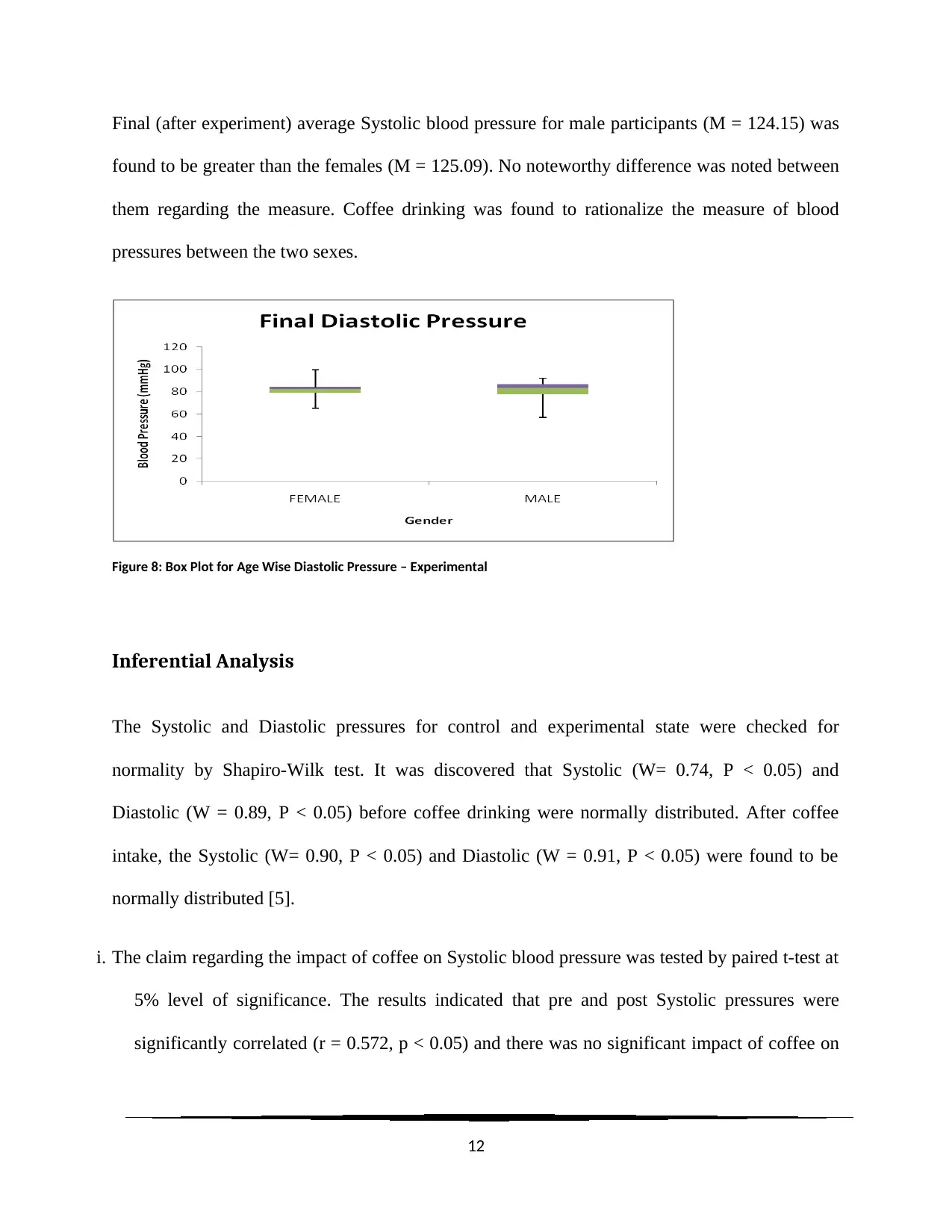
Final (after experiment) average Systolic blood pressure for male participants (M = 124.15) was
found to be greater than the females (M = 125.09). No noteworthy difference was noted between
them regarding the measure. Coffee drinking was found to rationalize the measure of blood
pressures between the two sexes.
Figure 8: Box Plot for Age Wise Diastolic Pressure – Experimental
Inferential Analysis
The Systolic and Diastolic pressures for control and experimental state were checked for
normality by Shapiro-Wilk test. It was discovered that Systolic (W= 0.74, P < 0.05) and
Diastolic (W = 0.89, P < 0.05) before coffee drinking were normally distributed. After coffee
intake, the Systolic (W= 0.90, P < 0.05) and Diastolic (W = 0.91, P < 0.05) were found to be
normally distributed [5].
i. The claim regarding the impact of coffee on Systolic blood pressure was tested by paired t-test at
5% level of significance. The results indicated that pre and post Systolic pressures were
significantly correlated (r = 0.572, p < 0.05) and there was no significant impact of coffee on
12
found to be greater than the females (M = 125.09). No noteworthy difference was noted between
them regarding the measure. Coffee drinking was found to rationalize the measure of blood
pressures between the two sexes.
Figure 8: Box Plot for Age Wise Diastolic Pressure – Experimental
Inferential Analysis
The Systolic and Diastolic pressures for control and experimental state were checked for
normality by Shapiro-Wilk test. It was discovered that Systolic (W= 0.74, P < 0.05) and
Diastolic (W = 0.89, P < 0.05) before coffee drinking were normally distributed. After coffee
intake, the Systolic (W= 0.90, P < 0.05) and Diastolic (W = 0.91, P < 0.05) were found to be
normally distributed [5].
i. The claim regarding the impact of coffee on Systolic blood pressure was tested by paired t-test at
5% level of significance. The results indicated that pre and post Systolic pressures were
significantly correlated (r = 0.572, p < 0.05) and there was no significant impact of coffee on
12
⊘ This is a preview!⊘
Do you want full access?
Subscribe today to unlock all pages.

Trusted by 1+ million students worldwide
1 out of 47
Related Documents
Your All-in-One AI-Powered Toolkit for Academic Success.
+13062052269
info@desklib.com
Available 24*7 on WhatsApp / Email
![[object Object]](/_next/static/media/star-bottom.7253800d.svg)
Unlock your academic potential
Copyright © 2020–2025 A2Z Services. All Rights Reserved. Developed and managed by ZUCOL.





